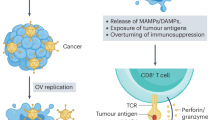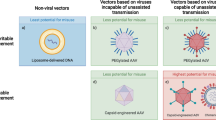Abstract
Replication competent oncolytic viruses, like other biological products, are at risk from contamination by bacteria, fungi, mycoplasma and viruses that must be eliminated from the final product. This article reviews the regulatory guidance for the manufacture and testing for oncolytic virus products. A testing strategy covering the testing of cell lines, virus banks, virus harvests and purified product is described.
This is a preview of subscription content, access via your institution
Access options
Subscribe to this journal
Receive 12 print issues and online access
$259.00 per year
only $21.58 per issue
Buy this article
- Purchase on Springer Link
- Instant access to full article PDF
Prices may be subject to local taxes which are calculated during checkout
Similar content being viewed by others
References
Melnick JL, Tinebaugh S . Excretion of vauloating SV40 virus (Papova virus group) after ingestion as a contaminant of oral poliovaccine Proc Soc Exp Biol Med 1962 109: 965–968
Uphoff CC, Drexler HG . Comparative PCR analysis for detection of mycoplasma infections in continuous cell lines In Vitro Cell Dev Biol Anim 2002 38: 79–85
Nettleton PF, Rweyemanu MM . The association of calf serum with the contamination of BHK21 clone 13 suspension cells by a parvovirus serologically related to the minute virus of mice (MVM) Arch Virol 1980 64: 359–374
Rabenau H, Ohlinger V, Anderson J et al. Contamination of genetically engineered CHO-cells by epizootic haemorrhagic disease virus (EHDV) Biologicals 1993 21: 207–214
Bolin SR, Ridpath JF, Black J et al. Survey of cell lines in the American Type Culture Collection for bovine viral diarrhoea virus J Virol Methods 1994 48: 211–221
Garnick RL . Experience with viral contamination in cell culture Dev Biol Stand 1996 49–56
Giangaspero M, Vacirca G, Harasawa R et al. Genotypes of pestivirus RNA detected in live virus vaccines for human use J Vet Med Sci 2001 63: 723–733
Croghan DL, Matchett A, Koski TA . Isolation of porcine parvovirus from commercial trypsin Appl Microbiol 1973 26: 431–433
Marcus-Sekura CJ . Introduction to the issues: detection of retroviruses and associated risks Dev Biol Stand 1992 76: 137–140
Anderson KP, Low MA, Lie YS et al. Endogenous origin of defective retrovirus-like particles from a recombinant Chinese hamster ovary cell line Virology 1991 181: 305–311
Robertson JS, Nicolson C, Riley AM et al. Assessing the significance of reverse transcriptase activity in chick cell–derived vaccines Biologicals 1997 25: 403–414
Weissmahr RN, Schupbach J, Boni J . Reverse transcriptase activity in chicken supernatants is associated with particles containing endogenous avian retrovirus EAV-0 RNA J Virol 1997 71: 3005–3012
Moore WA . Experience in cell line testing Dev Biol Stand 1992 76: 51–56
Hakku B, Halton DM, Mally M et al. Cell characterisation by use of multiple genetic markers In: Acton RT, Lynn JD, eds Eukaryotic Cell Cultures New York, NY: Plenum 1984 13–31
European Medicines Evaluation Agency. Note for Guidance on the Quality, Preclinical and Clinical Aspects of Gene Transfer Medicinal Products. London April 2001 CPMP/BWP/3088/99
USA Food and Drug Administration. Guidance for Industry: Guidance for Human Somatic Cell Therapy and Gene Therapy. Washington, DC March 1998
USA Food and Drug Administration. Points to Consider in the Characterisation of Cell Lines Used to Produce Biologicals. Washington, DC August 1993
International Committee for Harmonisation. Guidance on viral safety evaluation of biotechnology products derived from cell lines of human and animal origin USA Fed Regist 1998 63: 51074–51084
International Committee for Harmonisation. Guidance on quality of biotechnological/biological products: derivation and characterisation of cell substrates used for production of biotechnological/biological products USA Fed Regist 1998 63: 50244–50249
Medicines Control Agency. EC Guide to Good Manufacturing Practice. Rules and Guidance for Pharmaceutical Manufacturers and Distributors London: The Stationery Office 1997 43–202
European Commission. EC Guide to Good Manufacturing Practice: Annex 13. Manufacture of Investigational Medicinal Products. Brussels November 2001 Draft 1
European Commission. Directive 2001/20/EC of the European Parliament and of the Council on the approximation of the laws, regulations and administrative provisions of the Member States relating to the implementation of good clinical practice in the conduct of clinical trials on medicinal products for human use Off J Eur Communities 2001 121: 34–44
European Medicines Evaluation Agency. Note for Guidance on the Risk of Transmitting Animal Spongiform Encephalopathy Agents Via Human and Veterinary Medicinal Products. London 2001 EMEA/410/01
European Directorate for the Quality of Medicines. Cell substrates for the production of vaccines for human use In European Pharmacopoeia 4th ed Strasbourg: Council of Europe 2002 415–418
European Directorate for the Quality of Medicines. Tests for extraneous agents in viral vaccines for human use In European Pharmacopoeia 4th ed Strasbourg: Council of Europe 2002 148–149
Liebermann H, Mentel R . Quantification of adenovirus particles J Virol Methods 1994 50: 281–291
Stacey G, Bolton B, Doyle A, Griffiths B . DNA fingerprinting — a valuable new technique for the characterisation of cell lines Cytotechnology 1992 9: 211–216
Hane B, Tummler M, Jager K et al. Differences in DNA fingerprints of continuous leukaemia–lymphoma cell lines from different sources Leukemia 1992 6: 1129–1133
Nims RW, Shoemaker AP, Bauernschub MA et al. Sensitivity of isoenzyme analysis for the detection of interspecies cell line cross-contamination In Vitro Cell Dev Biol Anim 1998 34: 35–39
Parenteral Drug Association. Technical report no. 22. Process simulation testing for aseptically filled products PDA J Pharm Sci Technol 1996 50: S1
Parenteral Drug Association. Technical report no. 36. Current practices in the validation of aseptic processing — 2001 PDA J Pharm Sci Technol 2002 56: TR36
European Medicines Evaluation Agency. Draft Note for Guidance on the Use of Bovine Serum in the Manufacture of Human Biological Medicinal Products. London April 2002 CPMP/BWP/793/02
US Code of Federal Regulations. Requirements for Ingredients of Animal Origin Used for Production of Biologics. United States Government Printing Office. Washington, DC 2002 9 CFR 113.53
Hardegree MC . Letter to Industry US Food and Drug Administration, Division of Vaccines and Related Products Applications. Washington, DC December 14, 1998
European Directorate for the Quality of Medicines. Poliomyelitis vaccine (inactivated) In European Pharmacopoeia 4th ed Strasbourg: Council of Europe 2002 2206–2209
Lakshminarayanan S, Kodihalli S, Herrick S et al. Scalable purification of Reolysin for cancer therapy In Proceedings of 5th Annual Meeting American Society of Gene Therapy 2002 945
Huyghe BG, Liu X, Sutjipto S et al. Purification of a type 5 recombinant adenovirus encoding human p53 by column chromatography Hum Gene Ther 1995 6: 1403–1416
European Directorate for the Quality of Medicines. Biological tests, sterility In European Pharmacopoeia 4th ed Strasbourg: Council of Europe 2002 123–127
European Directorate for the Quality of Medicines. Biological tests; bacterial endotoxins In European Pharmacopoeia 4th ed Strasbourg: Council of Europe 2002 140–147
Author information
Authors and Affiliations
Corresponding author
Rights and permissions
About this article
Cite this article
Wisher, M. Biosafety and product release testing issues relevant to replication-competent oncolytic viruses. Cancer Gene Ther 9, 1056–1061 (2002). https://doi.org/10.1038/sj.cgt.7700536
Received:
Published:
Issue Date:
DOI: https://doi.org/10.1038/sj.cgt.7700536
Keywords
This article is cited by
-
Incubation Temperature and Period During Denarase Treatment and Microfiltration Affect the Yield of Recombinant Adenoviral Vectors During Downstream Processing
Molecular Biotechnology (2023)
-
Moving oncolytic viruses into the clinic: clinical-grade production, purification, and characterization of diverse oncolytic viruses
Molecular Therapy - Methods & Clinical Development (2016)
-
The nitroreductase prodrug SN 28343 enhances the potency of systemically administered armed oncolytic adenovirus ONYX-411NTR
Cancer Gene Therapy (2007)



